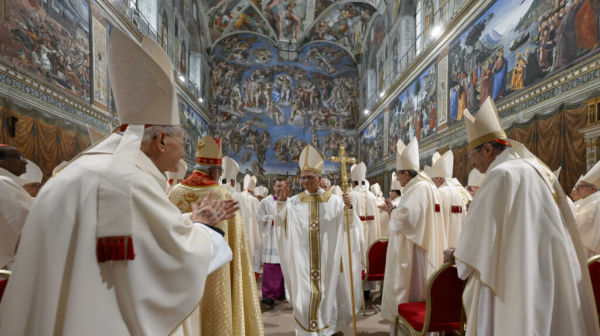In 2022, Hollywood star and motorcycle enthusiast Jason Momoa issued an apology after clicking pictures in the Sistine Chapel. Two years later, television personality Martha Stewart also drew condemnation for clicking photos inside the famous Vatican monument. Earlier this year, Vice President JD Vance stirred up controversy over a similar misstep. One must wonder why it’s such a big deal and whether the religious sanctity of the historical place is the reason photography is a big no-no. Well, you might be surprised to know that the Vatican’s no-photography rule inside the Sistine Chapel actually has origins in modern copyright laws. But how does a 15th-century Papal property fall under the aegis of copyright laws so strict that you can’t take pictures under the painted roof? Surely, it can’t be as sensitive as the White House to enforce such a ban.
Let’s start with the basics. Of all the places inside the Vatican jurisdiction where tourists are allowed, the Sistine Chapel is the one that is governed by a special set of rules. For example, visitors are told to gaze at the artistic marvels in “absolute silence.” And even if you are a part of a guided tour, all the historical knowledge should be imparted at the gates and not within the chapel’s premises. “The use of mobile phones is forbidden in the Sistine Chapel,” adds the Vatican’s rulebook for tourist decorum. Visitors are allowed to take pictures across the Vatican Museums for personal usage, but the Sistine Chapel is an exception.
And here’s the most interesting part. The copyright law that blocked photography originated from a deal with a Japanese media company: Nippon Television Network Corporation (NTV), which funded the costly restoration in exchange for exclusive photo and video rights.
A divine copyright?
According to an account published by Nova Southeastern Universityrestoration work was approved inside the Sistine Chapel back in 1980. However, the cost of restoration proved too high for the Vatican, prompting it to seek outside backers and solicit bids. Interestingly, it was NTV that emerged at the top with a bid of $3 million. According to The New York Times, the total amount eventually ballooned to $4.2 million. But why? Well, NTV was granted exclusive photography and video capture rights within the coveted halls. Apparently, the outcome was not bad for the Japanese media giant.
“Since making the deal, Nippon TV has made over a dozen documentaries, including a few in English, and coffee-table books of the art, translated into several languages,” writes historian and journalist Jason Ward, adding that the pictures clicked by Nippon were spectacular. According to The New York Timesthe documentaries were also a part of overseas distribution, but the company didn’t disclose any revenue details tied to the Sistine Chapel project. NTV’s exclusive photography rights only lasted three years, and by the time the project supposedly got over, all its copyright shields had expired as of 1997. Now, this is where things get interesting. If NTV’s exclusive access ended over two decades ago, why are tourists still banned from clicking pictures inside the Sistine Chapel? Well, this part of the story is rather boring.
Why does the ban persist?
Inside the museum halls, a whole bunch of camera- items and activities are prohibited. Items like drones, tripods, and stands are restricted from entry, and flash photography is strictly banned. You can, however, click pictures using a phone or any kind of camera. But when it comes to the Sistine Chapel area, any kind of photography is banned, and even the use of phones is not allowed. “The guard staff is authorised to request the immediate cancellation, in their presence, of video or photographic material produced in contravention of this rule,” says the Vatican Museum guide. It doesn’t mention why photography is banned, but it seems logistics challenges are to blame here.
In 2018, due to an outpouring of tourists, the Vatican started mulling a limit on the number of daily visitors. Tour guides working in the museum told The Guardian that roughly ten tourists faint each day, and in the summer season, the temperatures soar and the situation can get “hellish.” To make matters worse, air conditioning is limited, and there are only two emergency exits along the extended Sistine Chapel passageway. Needless to say, if tourists were allowed to wait and click pictures, they would block the movement of an already crowded space.
That is not just a logistics nightmare, but also poses a risk to the artwork itself. “Pressure caused by humans such as dust introduced, the humidity of bodies, carbon dioxide produced by perspiration can cause unease for the visitors, and in the long run, possible damage to the paintings,” an Italian critic wrote in a Vatican paper. With so many risks to tackle, it would make sense to keep the photography ban intact within the Sistine Chapel zone.










